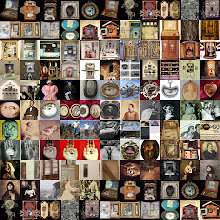During the private view of the exhibition La Petit Mort et la Grand Hysterie on Tuesday 21st January 2014 I saw the performance Cadaver Exquis: A Parlour Game, a collaboration between Gabriella Daris and Diana Pornoterrorista. What follows is Gabriella Daris' text on the piece.
CADAVRE EXQUIS: A PARLOUR GAME: LE SPECTACLE
A parlour game played with the cut-up technique - an exquisite corpse between the White Swan/Odette/Juliette and the Black Swan/Odile/Justine. Under the veil, the corpus is stimulated by ways of poetic imagination and body memory recollection, through the operation from concealment to revelation to concealment till they reach, the end. Do you think it is easy to get rid of a wound, to shut the mouth of a wound?[© Text copyright: Gabriella Daris, 2013]
LES POETS CORPOREL | LES SALONINNIERES
White Swan/Odette/Juliette: Gabriella DarisBlack Swan/Odile/Justine: Diana PornoterroristaThe performance involved two figures dressed in a black and a white burkha, representing a duality like white/black swan personifications, they will later reveal that they are naked underneath the garments, wearing white feathers around her long neck-Gabriella Daris- and a black feather mask, almost like a beard, surrounding her mouth-Diana Pornoterrorista.
The piece commences with Daris sitting, and the audience is asked by 'Odette' to cut pieces from her white burkah, with a pair of scissors, revisiting Yoko Ono's 1964 Cut Piece. We are asked to write on the white piece of fabric something that, based on our personal experience, is a prison for us. After a long time, when 'Odile' has barely any fabric covering her, Diana asks a member of the public to read out a text, while she collects the written bits of fabric from the audience, showing them to us, one by one, stapling them onto her flesh with a staple gun. From what I can recall, the text is a criticism to Western perspectives on the burkah, encouraging to turn 'our' (Western) critical (and prejudist) view onto our own issues, to stop criticising other cultures to look at our own, and the way in which we classify and label people to perpetuate forms of oppression.
The text is reflected in most of the words on the fabric, which have come to represent 'prisons' for their bearers, recalling a lot of insults and labels. Once the black swan is semi-covered once more by the shameful words, the white swan helps her take them off, one by one, and they are swallowed between the black feathered mouth, devoured, like an aggressive vengeful act. Each word is shown to the audience at a time before disappearing inside her mouth, and when Odile/Diana comes across one in particular, 'capitalism', she turns around and puts it up her ass, literally-in a physical metaphor.
The two characters, the white and the black burkahs, swans, with their emphasis on being a pair and somehow opposites and complementary, speaks to me of the way difference is constructed in society, in opposing pairs: female/male, homosexuality/heterosexuality, healthy/pathological, fat/thin, able/disable, black/white, strong/weak, self/other...etc. During the performance, the two artists don't function as opposites, but more as a pair working towards the same goal, revealing the body, covering it with the words-prisons- of many others, in a ritual where they are finally devoured and consumed.
Beyond, or underneath, the burkah, their nude female bodies are diverse, Diana's 'femenine' curves defied by her embodied rejection of gender stereotypes (in general in her practice as an artist), Gabriella's shows the signs of discipline and training from her formation as a classical dancer. Notions of active/passive are also explored, the two women shifting positions, Gabriella receiving the audiences cuts, cuts that become empowered in the transformation from cuts to words and from words to Diana's affirming action of self-stapling.
These are two bodies that have obvious presence in the work, from the moment they come to view and in the actions revolve around them: covering and revealing of them, cutting closely around, stapling on. The appearance of the wound in Gabriella's text, together with the concept of prison, as understood by the diversity of the personal audience's experiences, makes use of the burkah as a metaphor for the skin-as-prison, the site to reclaim the flesh in affirmative action, to define as individuals in all our diversity what it means. Perhaps the skin is the Westerner's (not only female) prison, far more subtle and engrained than any garment. Can wounds function beyond signs of abuse? Self-inflicted in affirmative creative action they defy passive/active assumptions of cutter and receiver, inflictor and victim.
The wound is a core concept in my practice, as can be seen on two of the prints I contributed to the show, The Anatomy of the Hidden Vagina and Incredulity. These together with the work of many other artists, Lizzie Learman amongst them, is still on show until the 19th April, at Blacks, 67 Dean Street, W1D 4QH London.
The Anatomy of the Hidden Vagina and Incredulity.

Lizzie Learman's Trouble and Strife




